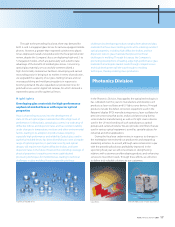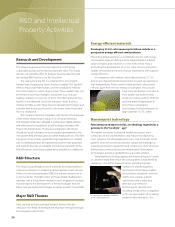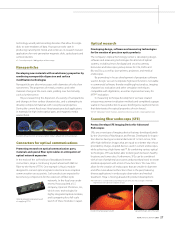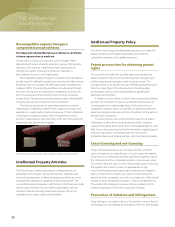Pentax 2008 Annual Report Download - page 29
Download and view the complete annual report
Please find page 29 of the 2008 Pentax annual report below. You can navigate through the pages in the report by either clicking on the pages listed below, or by using the keyword search tool below to find specific information within the annual report.
technology would yield recording densities that allow for single
disks to store terabytes of data. Hoya got an early start in
producing nanoimprint molds and continues its research toward
applications for next-generation magnetic disks, optical parts and
semiconductors.
*1 One terabyte equals 1,000 gigabytes of data storage.
Developing new materials with revolutionary properties by
combining nanoparticle dispersion and surface
modification technologies
Nanoparticles are ultra-microscopic with diameters of only a few
nanometers. The properties of metals, ceramics and other
materials change at the nano-scale, yielding new functionality,
such as luminescence.
Hoya is researching the dispersion of a variety of nanoparticles
and changes in their surface characteristics, and is attempting to
develop compound materials with new physical properties.
During the current fiscal year, Hoya targets practical applications
in materials for high index optical parts and magnetic media
related fields.
Promoting research on optical communication parts,
materials and special fiber optic cables in anticipation of
optical network expansion
In the midst of the swift rollout of broadband Internet
connections, Hoya is continuing to push ahead with R&D on
Fiber-to-the-Home (FTTH). One example is Hoya’s module
designed to convert optical signals to electrical ones at optical
communication access points. Such products are expected to
become key components for the extension of fiber optic
networks. In the fiscal year under
review, Hoya acquired a U.S.
company, Xponent Photonics, Inc.,
which owns technologies for
highly integrated optical modules,
and is preparing for a full-scale
launch of these modules in Japan.
Developing design, software and measuring technologies
for the creation of precision optics products
The Company’s Optical Technology Center is developing design,
software and measuring technologies for all kinds of optical
systems, including lenses for digital and security cameras,
binoculars and telescopes; pickup lenses for CDs, DVDs and
Blu-ray Discs; as well as laser printers, projectors and medical
endoscopes.
By promoting in-house development of proprietary software
used in design, we can incorporate high-level functions not viable
in commercial software, thereby enabling ghost analysis, imaging
characteristic evaluation and other simulation techniques
compatible with digitization, as well as improved accuracy for
MTF*2 evaluation.
In measuring technique development, we have created
unique measurement evaluation methods and completed a gauge
usable in mass production to assess birefringence (a phenomenon
that deteriorates the optical properties of resin lenses).
*2 MTF: Modulation Transfer Function, a benchmark for measuring lens imaging performance
Pentax Develops SFE Imaging Device for Advanced
Endoscopes
SFEs are a new type of imaging device that was developed jointly
by the University of Washington and Pentax. Developed for inspec-
tion devices having an external diameter of 1.2 mm or less, SFEs
offer high-definition images that are equal to or better than those
provided by charge-coupled devices used in current endoscopes,
while achieving a high frame rate*3. By combining various optical
technologies, SFEs are better able to distinguish between healthy
locations and tumor sites. Furthermore, SFEs can be combined
with a host of peripheral accessories and procedural tools to create
medical equipment with a host of new functions. The new SFEs
allow for the creation of endoscopes that are smaller in diameter
and offer more advanced functions than in the past, featuring
diverse applications in endoscopic observation and medical
treatment. Hoya is moving ahead with product development.
*3 Frame rate is a standard measure of frequency per time unit that an image is refreshed.
Higher frame rates generate smoother images.
Nanoparticles
Scanning fiber endoscope (SFE)
Connectors for optical communications
Optical research
Example of fluorescence of nanocrystalline indium phosphide semiconductors
Optical network component used
in supplying FTTH
Distal end of prototype probe Captured image with SFE probe
HOYA ANNUAL REPORT 2008 27
























